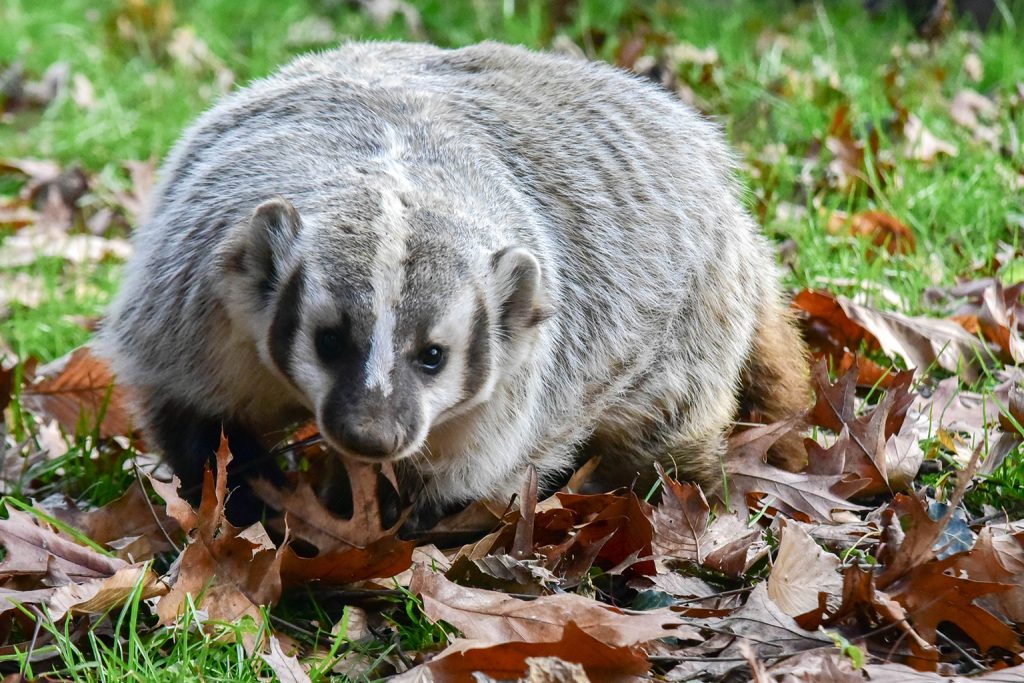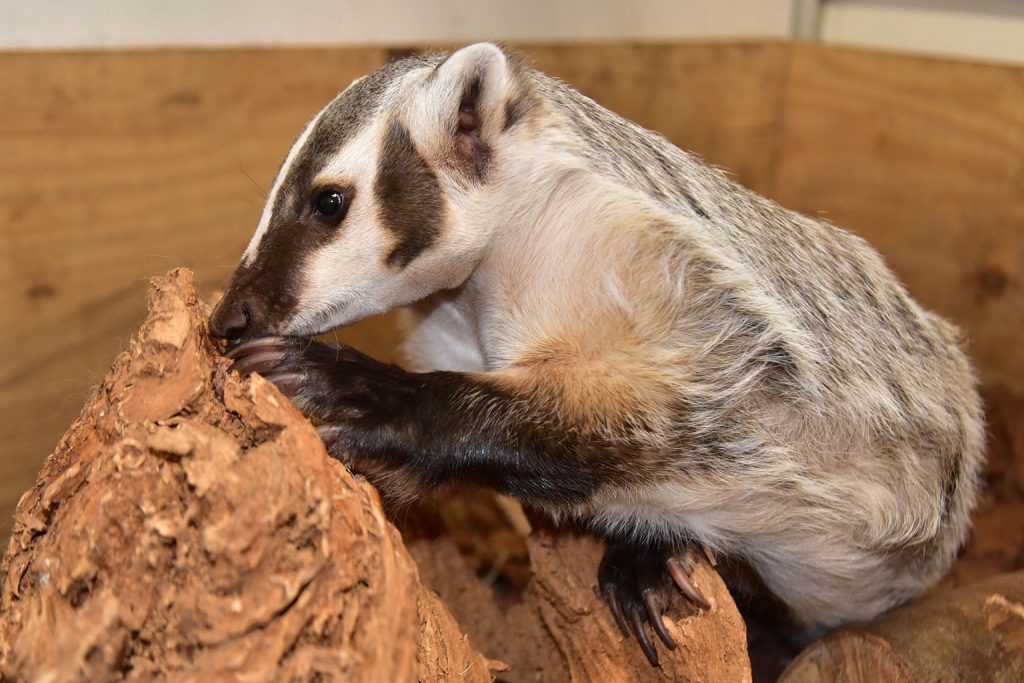Overview
“Where I Live”
The American badger is a North American mammal whose range extends from southern Canada to Mexico. It prefers dry and open terrain with little vegetation, including prairies, plains, and dry grasslands.
The Maryland Zoo features an American badger among its Animal Ambassadors, which are introduced to audiences in education programs on and off grounds.
“How I Live There”
American badgers are solitary animals of the western prairies. They shelter below ground in burrows of their own making. When not in their burrows, they are generally on the move in search of prey. They are specialized predators that feed on burrowing rodents such as gophers, ground squirrels, and prairie dogs. They are hunting opportunists, though, and will eat other prey that crosses their path, including a variety of insects, birds, reptiles, and amphibians. Badgers are primarily nocturnal and do most of their hunting at night.
In order to get their prey, badgers have to dig them out of their own burrows, and this is something they are well adapted to do. Everything about the American badger is made for digging. They are wedge-shaped like a garden spade, with small heads, thick necks, and powerful shoulders. They are built low to the ground. They have long, curved claws on their front feet and smaller rear feet with short, shovel-like claws. Their front feet are also partially webbed, keeping toes close together for even stronger digging. Their eyes are protected from flying dirt and dust by an inner lid or “nictitating membrane” that drops down when needed. They have loose skin that enables them to turn around in tight spaces.
During the warmer months of the year, badgers move around home ranges of 400 to 600 acres and may occupy a different burrow every day. They are not strictly territorial and their home ranges may overlap. As the weather cools, badgers return to a single den to spend the winter. Badgers put on weight during the summer and fall in anticipation of a long winter with little to no prey. They survive on extra body fat until the ground thaws the following spring. While badgers will come above ground to sun themselves on mild winter days, they spend the bitterly cold stretches below ground. To conserve energy, they enter torpor, a state similar to hibernation.
“Making My Mark”
Through predation, American badgers help control rodent populations in the ecosystems that they inhabit.
Raising Young
Male and female badgers come together only to mate, and breeding usually occurs in summer and early autumn. Females give birth to litters of 1-5 cubs while in their winter dens. Baby badgers are born tiny, blind, and helpless, weighing no more than a deck of cards. They will open their eyes at about 4 weeks but will remain below ground, nursing from their mother and putting on size before emerging in the spring. Young badgers are weaned at about two months of age but stay together and with their mothers through their first summer. By fall, they are ready to head off on their own.
“What Eats Me”
Bobcats, golden eagles, cougars, wolves, and bears often prey upon American badgers, but humans pose the greatest threat to this species. As more badger habitat is either developed or converted to farm or ranch land, badgers are targeted as a pest species by those who view their burrows as a risk to livestock or as an impediment to crop production. Badgers also are threatened by vehicle collision when they venture near roads and by accidental poisoning when they eat poisoned rodents.
Conservation
The American badger is listed as a species of least concern by the IUCN, the world’s leading conservation organization. Overall, the badger population remains stable, despite increasing human-related pressures.
Humans can support the conservation of American badgers by making simple and environmentally responsible lifestyle decisions to help conserve habitat. Actions to take include supporting renewable energy initiatives, reducing litter and pollution, and decreasing the use of pesticides and other hazardous materials and disposing of them properly.
Taxonomy
- Kingdom: Animalia
- Phylum: Chordata
- Subphylum: Vertebrata
- Class: Mammalia
- Genera: Taxidea
- Species: taxus
What is an Animal Ambassador?
The Maryland Zoo refers to its special collection of education program animals as “Animal Ambassadors.” The Zoo currently cares for more than 60 Animal Ambassadors, representing more than 40 species, both native and exotic. These animals are managed separately from the rest of the Zoo’s collection and cannot be seen on exhibit at the Zoo. However, many can be seen up close and personal on a rotating basis at Creature Encounters, the Zoo’s outdoor education center; at camp and school programs at the Zoo; as featured participants in community-based Outreach programs; and at special events on and off Zoo grounds.
Animal Ambassadors spend countless hours working with their human handlers, developing bonds of trust and communication that will allow them to appear in front of audiences large and small. They are not show animals. They behave naturally, focusing audiences’ attention on their natural behaviors and adaptations and giving living, breathing meaning to concepts and topics that students may be studying.
Animal Ambassadors travel all over the state of Maryland and beyond, and many also make local and national media appearances, educating about wildlife while representing the Zoo and its commitments to animal welfare and conservation.
What is The Animal Embassy?
The Animal Embassy at The Maryland Zoo is an off-exhibit area that is not open to the public. It is where the Zoo’s “Animal Ambassadors,” or education program animals, live. The Embassy is home to more than 60 individual animals representing more than 40 different species. It is staffed by its own dedicated group of keepers and volunteers and has both indoor and outdoor living space for the animals.


